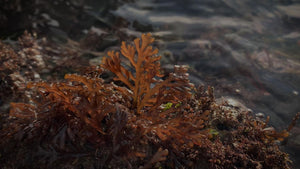I am the Practice Manager on the Outer Hebridean Isle of South Uist, where my husband is the local GP. In my spare time I write. I am the author of The Forager’s Kitchen, Seaweed in the Kitchen and Let Your Kids Go Wild Outside. I fell into Practice Management on the retirement of the previous Manager and in many ways the same can also be said of learning to cook with seaweed. Writing about seaweed began because there are few trees or hedgerows on my island. My foraging basket was limited and so I looked to the seashore.

On the Island, in common with most of the Western world, eating seaweed was synonymous with poverty, but currently seaweed is being discovered: in lowering methane admissions (global warming) in healthcare, wellness and nutrition and of course in haute cuisine restaurants such as NOMA.
PEPPER DULSE Osmundea pinnatifida
Pepper dulse has small, lacy fernlike fronds and a piquant peppery flavour. It is often overlooked and doesn’t appear to feature in folklore remedies. This may be because as Professor Guiry of NUI, Galway suggests its flavour comes from molecules called terpenes, which have a protective function and deter grazing molluscs and fish. For this reason he suggests that it is consumed in moderation. I enjoy its flavour but it is difficult to prise from the rocks and takes time to harvest. The French botanist Camille Sauvageau recorded that its special odour and piquancy is only evident in young plants collected in winter and spring and that by autumn, little is left in older plants. I question this because my autumn gatherings are garlic scented. Although the gatherings were icy affairs and unlike summer pickings, there was a calcified covering on the dried fronds. The phycologist, Amelia Griffith sampled pepper dulse and considered it excellent. This nineteenth century lady was unusual because most Westerners of her era did not include seaweed in their diet, unless there was a serious food shortage. The Dickensian journal Household Words reported that the dulse wives of Aberdeen sold pepper dulse but it would appear to have been mixed with the unrelated dulse (Palmaria palmata). Pepper dulse may be lighter to carry but it’s certainly more time consuming to harvest.

‘Pepper dulse Laurencia pinnatifida—is much more rare and more piquant than Iridea edulis. At Aberdeen every dulse-wife has ordinarily a few handfuls of pepper-dulse, half-a-dozen plants of which she adds when asked, to every halfpenny worth of dulse. Sometimes there is one who, being weakly, has nothing but pepper-dulse, which is less heavy to carry, and more costly than the common breakfast relish of the Aberdonians.’
Pepper dulse is a red seaweed and varies in colour from red through purple to brown, depending on where it has been picked. It is similar to royal fern weed Osmundea osmunda, but this is a much larger species growing to 20cm in length. Pepper dulse grows to 8cm and has a tangled creeping hold, which makes it very tricky to pick sustainably – without damaging the holdfast. Its frond is thick, almost fleshy with alternate branching and appears flattened as if it has been pressed. It thrives on open rocks in the middle and lower shores. There is also an epiphytic Osmundea oederi, which often attaches itself to the Fucus species.
This species is confined to the south and west coast of Britain. The other species, pepper dulse Osmundea pinnatifida is found throughout the UK coast. Pepper dulse takes considerable time to pick. Scissors are really the kindest way to collect this seaweed (to ensure that you don’t cut the twisted holdfast) and a mixed bag of small particles of rock and sand seem unavoidable. Scissors don’t work very well on gloved hands. In autumn harvesting is hard and cold work. Some say that it tastes of fish but to my palate, there is a distinct taste of garlic.
I use fresh pepper dulse on poached eggs, where the frond will turn green on contact with the albumen but remain red on the yolk. I’m unsure if this is chemistry, or a result of uneven cooking times. A handful of fresh pepper dulse fronds simmered in 600ml water makes a wonderful pink, piquant stock, which is excellent for risotto. I usually dry pepper dulse. I think that this is in part, due to the time that it takes to harvest. It seems a little indulgent to cook with fresh.

Pepper dulse freezes but I rarely bother, possibly due to that fact that it takes so long to pick. Succinctly, this seaweed is hard work to harvest but worth it. For my palate, less is more. The colour of pepper dulse varies (from yellow to red to almost black) for sure and I have a hunch that the season, the location and even the weather affects flavour. Research is needed.






